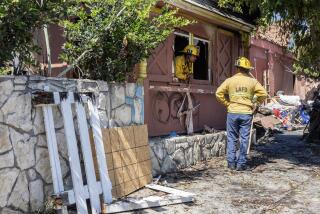At Age 65, the El Capitan Gets a Major Face Lift : Theaters: Disney and the Pacific Theaters movie chain have spent two years restoring the structure on Hollywood Boulevard, in time for âThe Rocketeer.â
After building an artificial Hollywood in Orlando, Fla., the Walt Disney Co. has turned its attention to the real thing.
A partnership of Disney and the Pacific Theaters movie chain invested an estimated $6 million in the restoration and relighting of a Hollywood legend: the 65-year-old El Capitan Theatre, on the real Hollywood Boulevard, in the real Hollywood, California--faded glamour district in the city of Los Angeles.
It took nearly two years of restoration to strip away the years of neglect and the pseudo-modern interior remodeling from the 1940s and 1950s to find the original decor.
But workers restored virtually all the architectural features created by theater designer G. Albert Lansburgh, who also designed Los Angelesâs Wiltern and Orpheum (now the Palace) theaters, as well the Shrine Auditorium interior.
The El Capitanâs original decor is said by historians to represent Italian Baroque on the facade and in the lobby, English Tudor in the wood-paneled lower lobby, and East Indian in the main auditorium.
In an interview Monday before a preview at the theater of Disneyâs âThe Rocketeer,â Dick Cook, president of Disneyâs Buena Vista Distribution, said Disney will make the El Capitan a showcase where the studio will debut its major feature films. Disney and Pacific Theaters already had jointly revived the much smaller, aging Crest Theater in Westwood, altering its decor to a Hollywood fantasy-land motif.
Disney and Pacific Theater officials originally planned to divide the theater in two and install an Art Deco interior. But they were persuaded by the landmark status of the El Capitan and such groups as Hollywood Heritage, the Los Angeles Historic Theatre Foundation and the L.A. Conservancy to go back to the original.
The effort has received enthusiastic support from the neighborhood. On Monday, Hollywood area and Los Angeles leaders announced the creation of a Cinema District along the boulevard in an effort to promote moviegoing. The district includes Mannâs Chinese, the Egyptian and the still-under construction Galaxy Theaters complex, among others.
Guests at Mondayâs screening got a preview of the glitzy show Disney has planned for tonightâs world premiere of âThe Rocketeer.â They entered under the splashy new rainbow-colored marquee and into the brightly gilded theater, with its oversized urns and purple, green and yellow carpeting.
In a Disneyland-like touch, ushers dressed in â30s style uniforms and caps swept up any popcorn that might have fallen on the new carpet.
On stage, a troupe of singing and tap-dancing ushers greeted the preview audience with a special show, to be presented only this week during previews.
Then the lights were lowered and the audience applauded as the elaborate curtains--three tiers of ornate tassels and silver tinsel--parted to fanfare music and revealed the giant 42x20-foot screen. The new sound system in the theater features THX and Cinema Digital Sound systems.
In the refurbishing, the number of seats was reduced from 1,500 to 1,100, providing more leg room for persons on the main floor.
The balcony area with its tiered seating has excellent sight lines, but leg room is limited, according to a number of guests.
Disney has moved the projection booth from the balcony to the first floor to improve projection capability and features for the hearing impaired and seating for handicapped were installed.
BACKGROUND
The El Capitan Theatre originally was designed as a venue for live performances, opening on May 3, 1926, with the musical, âCharlotâs Revue,â starring Jack Buchanan, Gertrude Lawrence and Beatrice Lillie. In the 1940s, when theater in general fell victim to hard times after the Depression, the El Capitan became a movie house. Orson Wellesâ âCitizen Kane,â was premiered there in 1941. It was later remodeled by covering the decor with curtains and features such as the box-seat balconies were removed. It reopened as the Paramount Theater in 1942, screening Cecil B. DeMilleâs âReap the Wild Wind.â
More to Read
The biggest entertainment stories
Get our big stories about Hollywood, film, television, music, arts, culture and more right in your inbox as soon as they publish.
You may occasionally receive promotional content from the Los Angeles Times.










